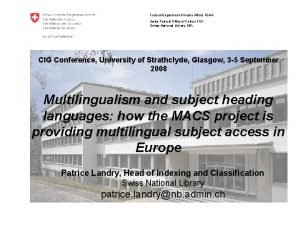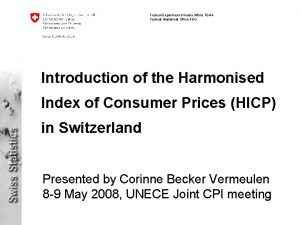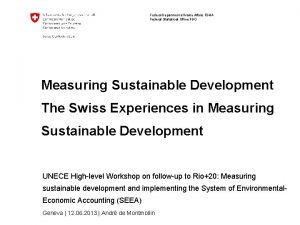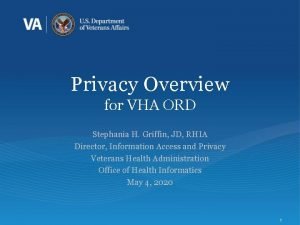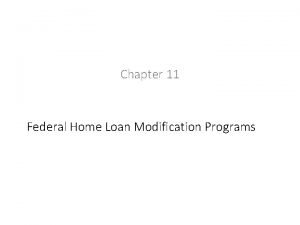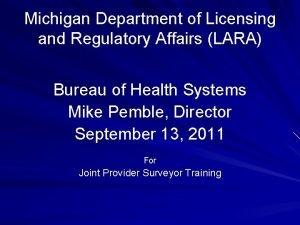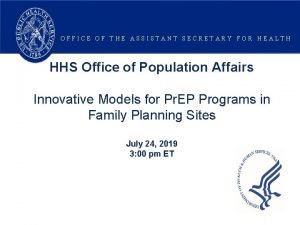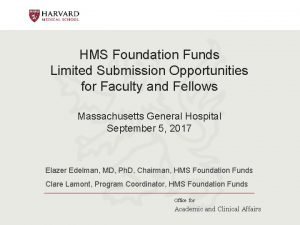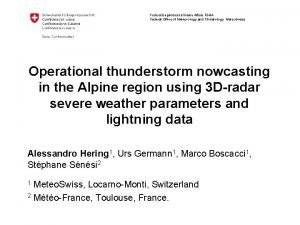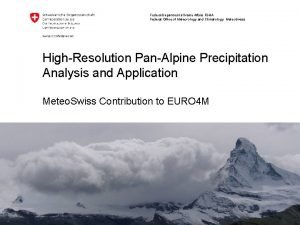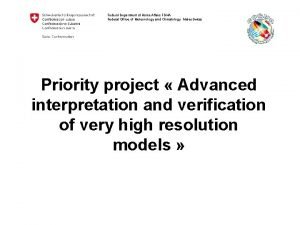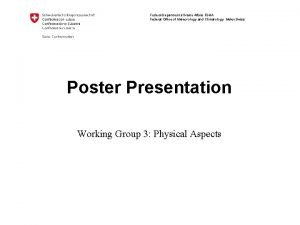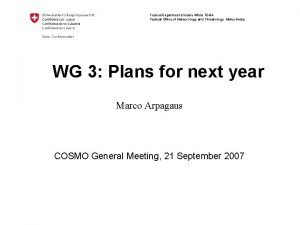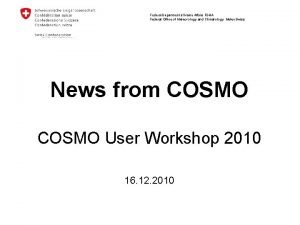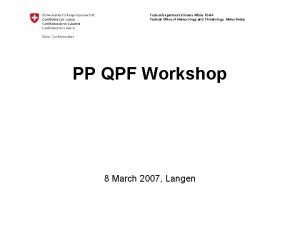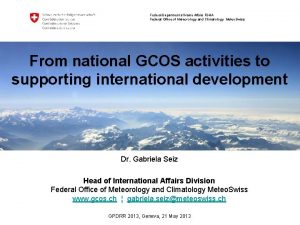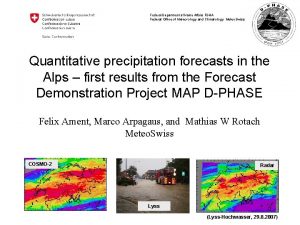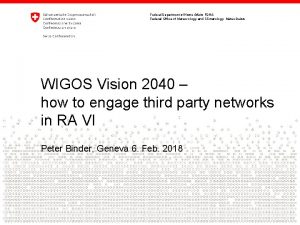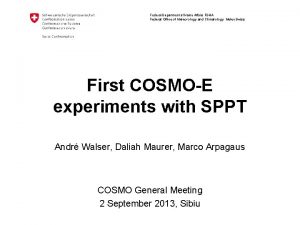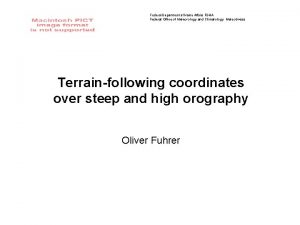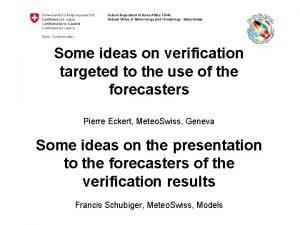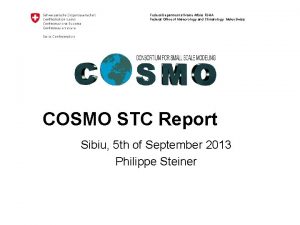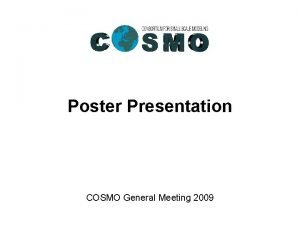Federal Department of Home Affairs FDHA Federal Office
















- Slides: 16

Federal Department of Home Affairs FDHA Federal Office of Meteorology and Climatology Meteo. Swiss WG 3: Status Report Marco Arpagaus COSMO General Meeting, 19 September 2007 Detailed status reports available on the COSMO web-site Acknowledgments: WG 3 members

WP 3. 1: Boundary layer (turbulence and surface transfer scheme) • 3. 1. 1: Revision of the transfer scheme together with the related documentation • 3. 1. 2: Reorganisation of the turbulence scheme and implementation of the 3 -d extension together with the completion of relevant documentation • 3. 1. 3: Extensions of the SC framework • 3. 1. 4: New concept for a roughness layer extension of the current turbulence scheme • 3. 1. 5: Higher vertical resolution for the lowest part of the boundary layer (NN) WG 3: Status Report 2

Revision of the near surface diagnosis (Raschendorfer; update) • COSMO-EU: • BL is too moist and too cold; despite this, T 2 m is too high at noon; this is particularly true for grid points with a large z 0 and an unnaturally moist soil. • Hypothesis: • diagnosed T 2 m is too high if compared to SYNOP measurements, especially for grid-points with large z 0; • SMA 'corrects' for this by adding water to the soil, thereby moistening and cooling the BL; • Problem of wrongly diagnosed T 2 m in COSMO-EU only visible when even a saturated soil can not correct the positive T 2 m bias • Cure: • Use z 0 = 0. 02 m for T 2 m diagnosis • Additional changes to stability functions needed, especially for stable stratification WG 3: Status Report 3

Deutscher Wetterdienst GME Verification of T 2 M: Routine, i. e. z 0=z 0(grid average) for T 2 M diagnosis

Deutscher Wetterdienst GME Verification of T 2 M: Experiment, i. e. z 0=z 0(SYNOP station) for T 2 M diagnosis

WP 3. 2: Grid-scale clouds and precipitation no regular WPs – but: • Revision of microphysical parameterisation (cloud ice & graupel schemes) by Axel Seifert • … poster by Axel Seifert and Michael Baldauf on 'Explicit forecasting of deep convection with COSMO-DE' • Supercell Detection Index • Sensitivity to PBL Scheme (diurnal cycle of deep convection) WG 3: Status Report 6

Sensitivity of the diurnal cycle to PBL assumptions: Precipitation frequency Hovmöller diagrams for Germany from 1 June to 21 July 2007 Radar • • Control run Less diffusive ‘dry’ PBL Now the radar observations show an even more pronounced diurnal cycle The current version of COSMO-DE is not able to reproduce this diurnal cycle A modified PBL scheme can help to get the diurnal cycle even on a 2. 8 km grid Obviously the mass average is dominated by larger-scale events, therefore the frequency diagram ist better for looking at the air mass / orographic convection which is weaker than the forced convection. COSMO General Meeting 2008, Athens, Greece -7 -

WP 3. 3: Convection WP 3. 4: Radiation • 3. 3. 1: Implementation of Kain-Fritsch scheme • 3. 4. 1: Cloud-radiation interaction • 3. 4. 2: Improve radiation treatment at small mesh-sizes ( Done! – WP is finished!) WG 3: Status Report 10

WP 3. 5: Lower boundary condition: soil and vegetation • 3. 5. 1: Revision of external parameters for plants (NN) • 3. 5. 2: Intercomparison of soil models in the framework of soil moisture validation poster by Gerd Vogel More sensitivities studies by Felix Ament ( poster: Evaluating modifications of the soil module TERRA) and Alexander Block (CLM) WG 3: Status Report 11

Meteorological Observatory Lindenberg – Richard Aßmann Observatory Soil moisture (3 -9 cm) Falkenberg site Gerd Vogel (DWD FELG)

Rain Result II Snow – Budget Summary CTL Evaporation SM Runoff_s mm Runoff_g mm Runoff_m mm Evapo. mm DSM mm l. E (JA) W/m 2 440 359 196 621 4 93 Deviations in mm Surface Runfoff Intermediate Runfoff Ground Runfoff Reduced Runoff RIGID -1 -97 7 22 75 5 GWATER 0 -29 3 7 22 1 BROOKS 1 -21 20 -116 -6 7 -2 Reduced interm. Runoff BROOKS 2 -20 61 -128 -30 -11 -4 BROOKS 1, BROOKS 2 BROOKS 3 - - - ECOSOIL 29 -22 -2 -14 10 -2 Reduced Evapo. (sustainable) MACROPOR -12 2 -18 4 6 1 NP 89, VEGPARA, Z 0 LOC PEDO -9 54 -65 -34 -10 -4 VEGPARA 1 32 13 -44 12 -6 Little impact ROOTDIST 0 -2 -1 1 2 -2 ROOTDIST, MACROPOR ECOVEG 29 -11 45 101 -118 17 NP 89 1 66 22 -84 18 -2 Problematic Z 0 LOC 25 9 2 -37 4 -3 ECOVEG (dry out!) COSMO GM, Athens Felix. Ament@meteoswiss. ch RIGID, GWATER 13

Uncertainty ranges T 2 m Yearly average daily temperature range Monthly average 14

WP 3. x: Lower boundary condition: snow • An advanced snow parameterization for the COSMOmodel poster by Ekaterina Machulskaya et al WG 3: Status Report 15

WP 3. 6: Lower boundary condition: lakes • 3. 6. 2: Implementation of lake model into the LM poster by Dmitrii Mironov • Done! – WP is finished! • Flake is ready to be used! • Flake is very popular (HIRLAM, UM, Météo-France, ECMWF, …) WG 3: Status Report 16

WPs 3. 7 to 3. 11 • 3. 7. 1: Urban turbulence parameterisation • 3. 8. 1: Implementation of mosaic approach • 3. 9. 1: High-resolution numerical modelling of deep moist convection dynamics • 3. 10. 1: Single column model studies • 3. 10. 2: Development of a tool for extended parameter determination (NN) • 3. 11. 1: Improve diagnosis of convective and turbulent gusts (NN) • 3. 11. 2: Investigate reason for cold/moist bias in PBL WG 3: Status Report 22

Priority projects • Towards a Unified Turbulence-Shallow Convection Scheme (‘UTCS’; PL: Dmitrii Mironov) talk by Dmitrii Mironov Note 1: Need (much …) more individual initiative from project participants! Note 2: Need a (much …) better idea of the individual tasks! • Tackle deficiencies in precipitation forecasts (‘QPF’; PL: Marco Arpagaus) talk by Silke Dierer WG 3: Status Report 23
 Federal department of home affairs fdha
Federal department of home affairs fdha Federal department of home affairs fdha
Federal department of home affairs fdha Federal department of home affairs fdha
Federal department of home affairs fdha Va form 10-250
Va form 10-250 Fdha loan
Fdha loan Michigan department of licensing and regulatory affairs
Michigan department of licensing and regulatory affairs Department of commerce and consumer affairs
Department of commerce and consumer affairs Department of local affairs
Department of local affairs Hhs office of population affairs
Hhs office of population affairs Ntust gym
Ntust gym Hms office of faculty affairs
Hms office of faculty affairs Aarti home care
Aarti home care Perbedaan home care dan home visit
Perbedaan home care dan home visit Homes for sale in roebuck sc
Homes for sale in roebuck sc Flower plural
Flower plural Come home come home jesus is calling
Come home come home jesus is calling Oak springs mobile home park
Oak springs mobile home park
